Technology has been part and parcel of our life for a long time, making our jobs more convenient and easy for us. This need for technology constantly changes with the application and the field involved. If you work in the radiology field or a radiology student, a laptop must work from home and store data like CT scans, X-RAY, or MRI. Therefore, some specific system requirements and features a laptop should have to be considered a good laptop for teleradiology. As a radiologist, if you are looking for the best laptop for teleradiology, this article can help you with some great options and answers to some basic questions about them.
Read Also : Best Laptops for Automotive Technicians
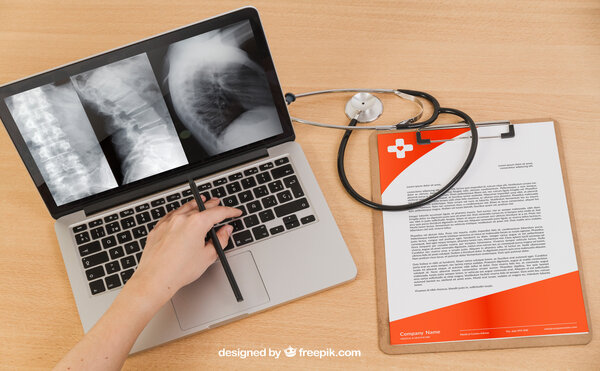
TOP-7 Best Laptop for Teleradiology
After countless hours of research, we narrowed it down to the 7 best laptops for teleradiology, reviewed them, and shown why they can be a good choice for you. Let have a look!
Our Top Picks For You
|
Best Macbook for Teleradiology |
Apple MacBook Air M1 |
|
|
Best Premium Laptop for Teleradiology |
Dell XPS 13 |
|
|
Best Detachable 2-in-1 Laptop for Teleradiology |
Microsoft Surface Pro 7 |
|
|
Best Touchscreen Laptop for Teleradiology |
HP Envy 13 |
|
|
Best Display Laptop for Teleradiology |
LG Gram 17 (2021) |
|
|
Best Bang for Buck Laptop for Teleradiology |
ASUS ZenBook 13 |
Apple MacBook Air M1 (2020) – Best Macbook for Teleradiology
Specifications
- Processor: Apple M1 (8-Core)
- Graphics: Integrated 7-core GPU
- Display: 13.3 inch IPS Retina True Tone display
- Display Resolution: 2,560 x 1,600 pixels
- RAM: 8GB Unified PDDR4X-4266 MHz SDRAM
- Storage: 256 GB PCIe SSD
- Weight: 2.8 lbs.
- Dimensions: 11.97 x 8.36 x 0.63 inches
Operating system: Windows 10 Home

MacBook’s has always been considered premium laptops great for different purposes like study, video and photo editing, or work in general. So as we were looking for good laptops for teleradiology, MacBook Air M1 grabbed our attention with Apple’s new M1 chip and a superb display as always.
Display and Build
This MacBook has a 13.3 LED display with a max brightness of 400-nit, with Apple’s retina display technology provides higher pixel density than traditional laptops. In addition, it has a resolution of 2560 x 1600, and with Apple’s True Tone technology, you get the best color and image production depending on your surrounding’s light. Combining all this, this laptop has a display very beneficial for teleradiology and a real treat for your eyes. Moreover, with the performance boost every year, Apple has managed to keep the design and build as compact and lightweight as possible, making it a good portable laptop.
Processor and Graphics
The performance of this laptop is no less than any other premium or more ambitious laptop lineups out there. With Apple’s new M1 chip, this laptop has performance boosts over its predecessors with low power consumption running for a long time with one charge. There is an 8-core GPU integrated with the laptop that performs great in sync with the M1 chip. The processor on this laptop should provide you with more than enough power you need for teleradiology.
Storage and Ram
For the base model, MacBook M1 comes with 256 GB SSD storage and 8 GB RAM, and both the RAM and SSD perform excellent with the fantastic hardware optimization Apple offers. These should be enough for all your teleradiology work, and you have the option to upgrade later too.
Reasons to buy
This laptop is a shocking combination of outstanding performance with a relatively lower budget. This is the cheapest MacBook to date but still provides you all the features needed for teleradiology.
Pros
- Fantastic value for the money
- Faster and more responsive macOS
- Great battery life
- Comfortable and accurate keyboard and mouse
- Optimized hardware and software
Cons
- Limited port options
Dell XPS 13 – Best Premium Laptop for Teleradiology
Specifications
- Processor: Intel Core i7-1185G7
- Graphics: Intel Iris Xe Graphics
- Display: 13.4-inch FHD+ touch display
- Display Resolution: 1920 x 1200 pixels
- RAM: 16GB LPDDR4x Memory
- Storage: 512GB M.2 PCIeNVMe SSD
- Weight: 2.8 pounds lbs.
- Dimensions: 11.6 x 7.8 x 0.6 inches
- Operating system: Windows 10 Home
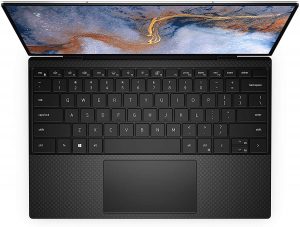

If you have been waiting for a lightweight teleradiology laptop with a good display, your wait is over. With the latest hardware and a beautiful touchscreen display, XPS 13 is a premium windows laptop that’s worth the money it costs.
Display and Build
This laptop has a 13.4-inch FHD+ edge-to-edge display with an unusual 16:10 aspect ratio that gives a more immersive viewing experience and creates more room for work on the display. The colors are super accurate and vibrant, the sharpness is on point, and with a maximum brightness of 361 nits, images on this laptop super gorgeous. The bezels are pretty small; even the bezel down the screen is as slim as the other bezels. Because of this slim design and small footprint, you can easily slide this into your backpack and carry it everywhere.
Processor and Graphics
This particular XPS 13 we are reviewing here packs Intel’s latest Core i7-1185G7 and integrated Irish Xe graphics. This processor can deliver more power than your teleradiology work may need. After all these years with UHD graphics for past generations, Inter raised their game with Irish Xe graphics, and it will handle all your graphical needs smoothly.
Storage and Ram
XPS 13 has a 16 GB Dual Channel LPDDR4x RAM. So now you can do as much multitasking you want and opening as much software as you wish to run in the background. Moreover, file storing and transfer on this laptop is just a matter of seconds; all credit goes to its super-fast 512GB M.2 PCIeNVMe SSD.
Reasons to buy
XPS laptops have been a popular lineup for different telemedicine works. This time with a great display and good performance, 2021’s Dell XPS 13 is more appealing than ever. The latest hardware will also make sure that it serves you well after years of usage. 







Read More : Best Laptop for Insurance Agents
Pros
- High-resolution, vibrant display
- Attractive, slick chassis with the smallest bezels
- Amazing performance
- Touchscreen support
- Fingerprint sensor for added security
Cons
- Average battery life because of the demanding display
Microsoft Surface Pro 7 – Best Detachable 2-in-1 Laptop for Teleradiology
Specifications
- Processor: Intel Core i5 1035G4 processor
- Graphics: Intel Iris Plus Graphics
- Display: 12.3 inch
- Display Resolution: 2736 x 1824 pixels
- RAM: 8GB LPDDR4x Ram
- Storage: 256GB SSD
- Weight: 1.7 pounds
- Dimensions: 11.5 x 7.9 x 0.33 inches
Operating system: Windows 10 Home
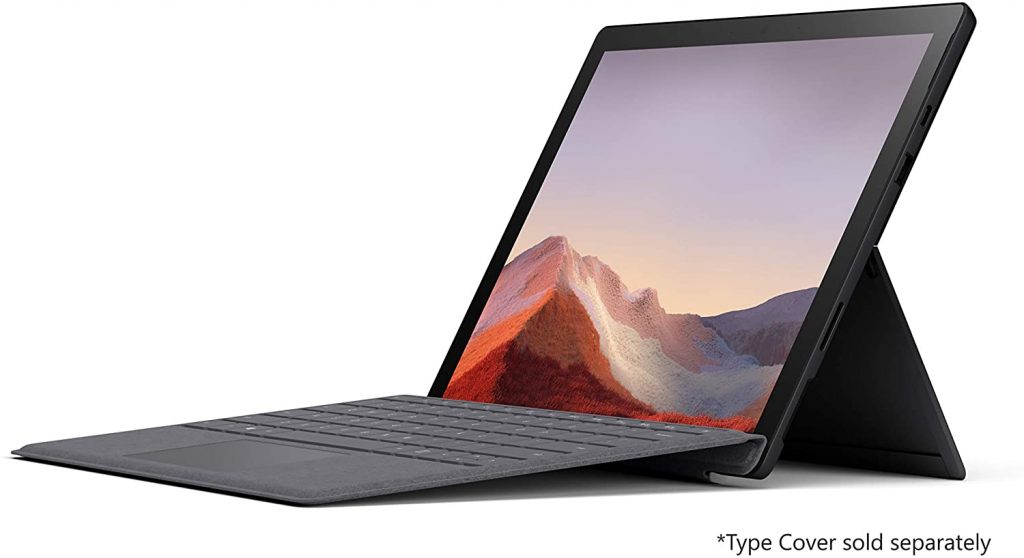

Microsoft Surface Pro 7 can be another good choice as a teleradiology laptop. The key features of this laptop are the portability and the upgrade over the last Surface Pro model with Intel’s Ice Lake 10th gen chipset. This particular device is more like a tablet that a laptop can use with its detachable keyboard and touchpad but performs no less than a full-blown laptop.
Display and Build
The display of this 2 in 1 device has all the good qualities you expect at this price. It’s color accurate, vibrant sharp, providing a very soothing viewing experience. Adding up to that, the touch response is also great, making the overall display more impressive. The keyboard is detachable, and you can use it as a tablet too. Build wise; this is the most lightweight device on our list with a super slick body; you can carry it around even in your hand and see what’s going on even when walking.
Processor and Graphics
This laptop equips an Intel Core i5 1035G4 processor inside, which is excellent for a tablet-sized device like this. It can handle everything you throw at it. There is also an integrated Intel Iris Xe graphics chip with the processor, which may not be as powerful for heavy gaming, but really lifts the whole performance and makes the device snappier.
Storage and Ram
This particular model we are reviewing comes with an 8GB LPDDR4x Ram and 256GB SSD inside. This amount of RAM should be enough to run all the teleradiology software you intend to run with other multitasking jobs. Combined with the RAM and impressive read and write speeds, this device just runs like a charm.
Reasons to buy
Even in 2021, the Surface Pro 7 from last year is arguably the king of the 2 in 1 detachable laptop category. If you want something lightweight enough to work around holding in hand with reasonably powerful hardware, this laptop is the best option for you.
Read Also: Best laptop for graphic design beginners
Pros
- Solid build quality
- Brilliant detachable keyboard (Additional purchase)
- Kickstand behind to set it up
- One of the best touch screens in any laptop
- Good battery backup
- Surface pen support
Cons
- Limited port selection
- No great for heavier tasks
HP Envy 13 – Best Touchscreen Laptop for Teleradiology
Specifications
- Processor: Intel Core i7-1165G7
- Graphics: Intel Iris Xe Graphics
- Display: 13.3-inch FHD Touchscreen Display
- Display Resolution: 1920 x 1080 pixels
- RAM: 8 GB DDR4 RAM
- Storage: 256 GB PCIeNVMe M.2 SSD
- Weight: 2.88 lbs.
- Dimensions: 12.05 x 8.35 x 0.58 inches
- Operating system: Windows 10 Home
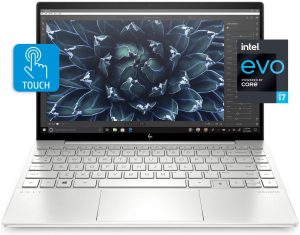

HP Envy 13, like its previous version from 2019, is an excellent choice if you have a budget under thousand dollars. With the latest hardware like Intel’s Tiger Lake CPU and faster SSD, it delivers a smooth experience and a longer battery life, just what you expect from a teleradiology laptop.
Display and Build
This convertible laptop has a 13.3-inch FHD touchscreen display, and the availability of a touch screen is a great feature to have at this price range. It isn’t something fancy like an OLED or 4K panel, but you shouldn’t expect them with a price tag under a thousand dollars. Instead, this display checks all the basics like color accuracy, good contrast, and sharpness. The build and design aesthetic is one of the most premium in this budget. With a sleek metal chassis and a chrome trim around the touchpad, this laptop looks gorgeous.
Processor and Graphics
We reviewed the Tiger Lake i7 variant of the HP Envy 13 here, and this variant makes an outstanding balance of performance and power all teleradiology work. Combined with the integrated Intel Xe graphics, this laptop can easily outperform any current-gen laptop model.
Storage and Ram
There is an 8GB DD4 RAM and a 256 GB PCIeNVMe M.2 SSD equipped with the laptop. 8 GB RAM may not be the highest one, but it should be enough to run the teleradiology software of your choice. In addition, the SSD is pretty fast and performs perfectly for fast boot-up, data transfer, or other day-to-day tasks.
Reasons to buy
If you want the latest processor and touchscreen in a compact and stylish notebook under thousand dollar budget, you can go for this device with your eyes closed. 







Pros
- Fingerprint reader for added security
- Solid all-metal design
- Latest hardware on board
- Touchscreen at a lower budget
- Great value for money
Cons
- No thunderbolt ort
- Plastic touchpad
LG Gram 17 (2021) – Best Display Laptop for Teleradiology
Specifications
- Processor: Intel Core i7-1165G7
- Graphics: Intel Iris Xe Graphics
- Display: 17 inch IPS LCD 60Hz display
- Display Resolution: 2560 x 1600 pixels
- RAM: 16 GB DDR4 Ram
- Storage: 1 TB NVMe M.2 SSD
- Weight: 2.98 lbs.
- Dimensions: 14.97 x 10.24 x 0.7 inches
- Operating system: Windows 10 Home
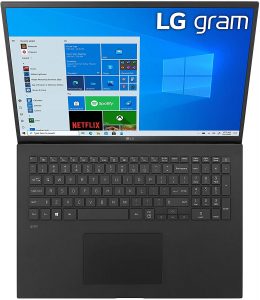

Teleradiology may often need you to work from home. If other 13 or 15-inch laptops are not cutting it for you, you might want to move out to something bigger. In that case, LG Gram 17 can be a great choice for you with its large QHD screen and all the other good features.
Display and Build
The 17-inch display has a resolution of 2,560 x 1600 pixels, basically the 16:10 version of the QHD monitor. Then this produces vibrant, sharp images with a high level of visual detail you may need for accurate teleradiology. If you are not working, this is also an excellent option for media consumption too. Overall, the display of the LG Gram 17 is the star of the show. LG built this laptop magnesium alloy, and that’s how they succeeded in keeping the weight just under 3 pounds with the big 17-inch display.
Processor and Graphics
The processor used in this device is the latest Core i7-1165G7, which you may have seen often in other premium ultrabooks released in 2021. In addition, for graphics, there is an integrated Intel Iris Graphics chipset. Both the CPU and its graphics combined, this Tiger Lake processor does a fantastic job at handling multiple heavy apps simultaneously, allowing you to multitask efficiently.
Storage and Ram
This year’s new LG Gram 7 features 16 GB high-speed LPDDR4X RAM and 1 TB NVMe M.2 SSD onboard. Because of the increased 4266 MHz speed, LG says the RAM is around 33% faster than the previous 3200 MHz bus RAMs. The storage capacity is massive too, 1 TB, the largest on our list, providing ample space to store all the data you want.
Reasons to buy
Overall, LG has beautifully executed a near-perfect portable Ultrabook with 2021’s Gram 17. The screen of this device is the most appealing feature here, and paired with the latest hardware, what more can you expect for a teleradiology laptop? 







Pros
- Excellent QHD display with wide viewing angle and aspect ratio
- Intel’s latest Tiger Lake CPU
- Good port selection
- Fingerprint sensor for extra security
- Long battery life
- Pretty lightweight despite the screen size
Cons
- No customization option
- No touchscreen support
ASUS ZenBook 13 – Best Bang for Buck Laptop for Teleradiology
Specifications
- Processor: Intel Core i7-1165G7
- Graphics: Intel Iris Xe Graphics
- Display: 13.3-inch OLED FHD display
- Display Resolution: 1920 x 1080 pixels
- RAM: 16GB 3733 MHz LPDDR4X
- Storage: 512 GB PCIeNVMe M.2 SSD
- Weight: 2.45 lbs.
- Dimensions: 11.98 x 7.99 x 0.55 inch
- Operating system: Windows 10 Home
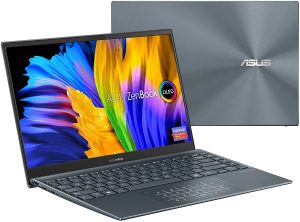

As we mentioned in the FAQ section below, display quality should be on your priority list for a teleradiology laptop. As far as the display goes, This Zenbook 13 has an excellent OLED display, which is rare and hard to pull out with a budget of little over a thousand dollars.
Display and Build
This laptop features a 13.3-inch display with only FHD resolution, but the OLD panel does all the magic here despite the mediocre resolution. The image production looks terrific with high contrast and vibrant colors. In addition, Asus used aluminum alloy to build the chassis, and the laptop itself is only 0.55 inches thick. As a result, the laptop is super lightweight and portable.
Processor and Graphics
The computing power of this laptop is pretty good, thanks to Intel’s latest Tiger Lake i7 processor inside. With the new processor, it has integrated Iris Xe graphics to fulfill the graphical need. Intel promised a better CPU than its previous generations, and it seemed like they delivered successfully too. So you can sail through your teleradiology work with this laptop.
Storage and Ram
This laptop boasts 16 GB LPDDR4X RAM and a 512 GB M.2 PCI SSD for memory and storage. So you can open a bunch of documents or keep browsing with any teleradiology work going on, and the fast storage and a large amount of RAM will handle them with ease.
Reasons to buy
Overall, the ZenBook 13’s slim, lightweight body, great hardware make it an excellent laptop for teleradiology. The OLED display is the highlight feature here, and the price more than justifies the benefits you get.
Pros
- Great OLED display in the budget
- Ultra-slim design
- Great battery backup
- Numbers of different ports
- Latest Intel CPU
Cons
- No thunderbolt support
Acer Swift 3 – Best Budget Laptop for Teleradiology
Specifications
- Processor: Intel Core i7-1165G7 Processor
- Graphics: Intel Iris Xe Graphics
- Display: 14-inch FHD IPS 60Hz display
- Display Resolution: 1920 x 1080 pixels
- RAM: 8 GB LPDDR4X RAM
- Storage: 256GB NVMe SSD
- Weight: 2.65 lbs.
- Dimensions: 12.73 x 8.62 x 0.63
- Operating system: Windows 10 Home


Acer Swift 3 is the budget option on our list; if you are low on budget but still want performance like the top-tier ultrabooks, Acer Swift 3 has got you covered with a decent display and some fundamental yet valuable features.
Display and Build
The display of this laptop doesn’t offer anything extraordinary, and honestly, it’s not right to expect something fancy too at this price range. So instead, Acer tried to nail the basics with their display. The 14-inch FHD panel has a wide viewing angle with good colors and sharp images production. For the build, this laptop equips a full metal chassis with materials like aluminum and magnesium. As a result, this laptop feels pretty solid yet lightweight, weighing about a mere 2.65 lbs. This is one of the most portable laptops in this budget category, with other 14 inch laptops available in the market.
Processor and Graphics
For the price, Acer Swift 3 offers a fairly powerful configuration to work with. Acer used Intel’s latest i7 1165G7 processor with integrated Iris Xe graphics, which we are usually used to see in more powerful and pricier ultrabooks. However, the performance is always outstanding, and the fact that Acer managed to fit in this processor within this budget is awe-inspiring.
Storage and Ram
Acer Swift 3 features 8GB of LPDDR4 RAM and 256 GB NVMePCIe SSD with the option to expand them later as needed. We admit other laptops have more ram and storage out there, but for the price, the following pair of RAM and SSD should serve you well enough for teleradiology work.
Reasons to buy
If you are to buy this laptop, the main highlight of this device is the powerful and latest hardware implementation for a relatively lower price. So, the hardware is great, and as per other features, like the display, build quality, or battery life goes, there is nothing terrible happening with these things. So, with a tight budget in mind, this should be a great buy indeed. 







Pros
- Thin and lightweight design
- Great value for the money
- Sharp, bright display
- Good variety of different port options
- Latest Intel processor onboard
- Fingerprint reader for added security
Cons
- Speakers aren’t great
- Display brightness can be an issue for some
More Info : Features to consider when buying a laptop in this year
Frequently asked questions
Here are some common questions Teleradiology inquire about laptops-
Q: What are the features to consider for a good teleradiology laptop?
A: A color-accurate and high-resolution display should be on top of your priority list. For teleradiology, you provide your expertise by seeing the radiology files that appear on your laptop screen, and you must see them on a sharp, high-resolution display for accurate results.
Still, if you are not satisfied, you can always use an external monitor too. Portability is another issue; make sure you choose one lightweight enough to carry around your home and workplace easily. Finally, it doesn’t take something too powerful in terms of performance, try to grab one with the last-gen Intel i5 or Ryzen 5 chips, and you should be all set.
Q: Are teleradiology laptops suitable for day-to-day use?
A: Absolutely. Teleradiology laptops possess nothing extra than a laptop we use daily. If you want, you can use them for any day-to-day task, study, or media consumption. They are just basic laptops, but the priorities here are great display and portability.
You can choose almost any computer and do everything you want. Just make sure that the laptop features a great display, decent performance, and portable enough to carry around.
Q: Which operating system should I choose is for radiology?
A: As long as you are using these laptops just for your teleradiology work, which operating system you choose depends on which software you prefer to use. You can either a MacBook or a Windows laptop; both are fine. Both operating systems offer different software for teleradiology.
MacBook’s have always been lightweight and powerful laptops with a great display, but if you look around a little, you will find windows laptops with the same qualities too.
Conclusion
Teleradiology is another example of how technology has changed our lives by making clinical information transfer so easy. As a radiologist, you can provide your insight to your patient without being present in the hospital and clinic. To do that, a laptop with a good screen, battery life, and portability can make your job easier.
Our review tried to make the product selection as diverse as possible, categorizing what makes a laptop great. All the laptops we choose should be an excellent choice for you, as each one of these laptops has all the basics a teleradiology laptop should have. Just pick one according to your budget and priority, and you are good to go.